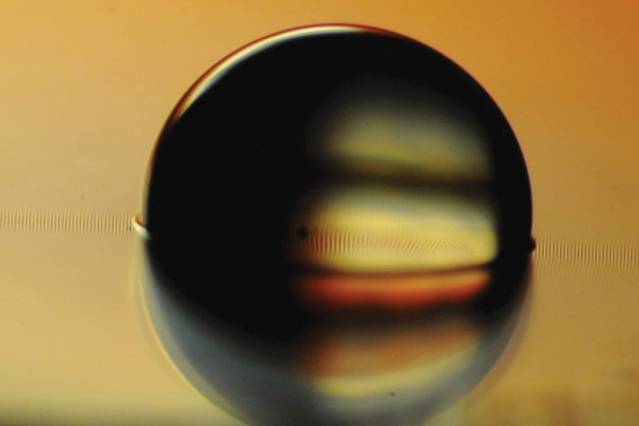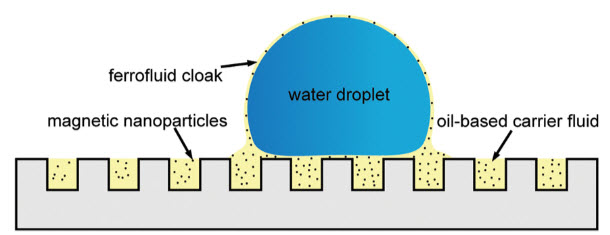‘Active’ surfaces that control fluids or particles
August 5, 2014

Photo of a water droplet sitting on a ferrofluid-impregnated surface, which has cloaked the droplet with a very thin layer.
Imagine a treated surface that that can actively control how fluids or particles move across it.
That’s what researchers at MIT and in Saudi Arabia have developed, using a simple microtextured surface, with bumps or ridges just a few micrometers across.
They impregnated the surface with a fluid that can be manipulated — for example, an oil infused with tiny magnetic particles, or ferrofluid, which can be pushed and pulled by applying a magnetic field to the surface.
When droplets of water or tiny particles are placed on the surface, a thin coating of the fluid covers them, forming a magnetic cloak.The thin magnetized cloak can then actually pull the droplet or particle along as the layer itself is drawn magnetically across the surface.

Schematic of surface with water droplet (also seen in video) resting on top (credit:
Karim S. Khalil et al./Applied Physics Letters)
MIT | Video produced and edited by Melanie Gonick. Footage courtesy of the researchers. Music sampled from: “Light Thought var 2” Kevin MacLeod (incompetech.com).
Active surfaces
Practical uses? The researchers suggested solar panels that could automatically clean themselves of dust and grit, for example. “Most surfaces are passive,” says Kripa Varanasi, an associate professor of mechanical engineering at MIT, and senior author of a paper describing the new system in the journal Applied Physics Letters. “They rely on gravity, or other forces, to move fluids or particles.”
Varanasi’s team decided to use external fields, such as magnetic fields, to make surfaces active, exerting precise control over the behavior of particles or droplets moving over them.
Tiny ferromagnetic particles, approximately 10 nanometers in diameter, in the ferrofluid could allow precision control when it’s needed — such as in a microfluidic device used to test biological or chemical samples by mixing them with a variety of reagents. Unlike the fixed channels of conventional microfluidics, such surfaces could have “virtual” channels that could be reconfigured at will.
Its superslippery surface, which lets fluids and particles slide around with virtually no friction, needs much less force to move these materials. “This allows us to attain high velocities with small applied forces,” says MIT graduate student Karim Khalil, the paper’s lead author.
Other researchers have developed systems that use magnetism to move particles or fluids, but these require the material being moved to be magnetic, and very strong magnetic fields to move them around, the researchers say.
Solar panels and the mirrors used in solar-concentrating systems can quickly lose a significant percentage of their efficiency when dust, moisture, or other materials accumulate on their surfaces. But if coated with such an active surface material, a brief magnetic pulse could be used to sweep the material away.
But at present, even in desert locations, the only way to counter this fouling is to hose the arrays down, a labor- and water-intensive method. The new approach, the researchers say, could lead to systems that make the cleaning process automatic and water-free.
“In the desert environment, dust is present on a daily basis,” says co-author Numan Abu-Dheir of the King Fahd University of Petroleum and Minerals (KFUPM) in Saudi Arabia. “The issue of dust basically makes the use of solar panels to be less efficient than in North America or Europe. We need a way to reduce the dust accumulation.”
One advantage of the new active-surface system is its effectiveness on a wide range of surface contaminants: “You want to be able to propel dust or liquid, many materials on surfaces, whatever their properties,” Varanasi says.
MIT postdoc Seyed Mahmoudi, a co-author of the paper, notes that electric fields cannot penetrate into conductive fluids, such as biological fluids, so conventional systems wouldn’t be able to manipulate them. But with this system, he says, “electrical conductivity is not important.”
While this initial demonstration used a magnetic fluid, the team says the same principle could be applied using other forces to manipulate the material, such as electric fields or differences in temperature.
What else could this kind of active surface accomplish? A new kind of lenticular image display that visually follows you? Braille interface? Diagnostic device? Invisibility cloak?
The work was supported by the MIT-KFUPM Center for Clean Water and Clean Energy.
Abstract of Applied Physics Letters paper
Droplet manipulation and mobility on non-wetting surfaces is of practical importance for diverse applications ranging from micro-fluidic devices, anti-icing, dropwise condensation, and biomedical devices. The use of active external fields has been explored via electric, acoustic, and vibrational, yet moving highly conductive and viscous fluids remains a challenge. Magnetic fields have been used for droplet manipulation; however, usually, the fluid is functionalized to be magnetic, and requires enormous fields of superconducting magnets when transitioning to diamagnetic materials such as water. Here we present a class of active surfaces by stably impregnating active fluids such as ferrofluids into a textured surface. Droplets on such ferrofluid-impregnated surfaces have extremely low hysteresis and high mobility such that they can be propelled by applying relatively low magnetic fields. Our surface is able to manipulate a variety of materials including diamagnetic, conductive and highly viscous fluids, and additionally solid particles.